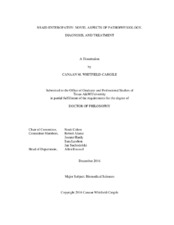| dc.contributor.advisor | Cohen, Noah D | |
| dc.creator | Whitfield-Cargile, Canaan M | |
| dc.date.accessioned | 2017-03-02T16:46:08Z | |
| dc.date.available | 2018-12-01T07:20:26Z | |
| dc.date.created | 2016-12 | |
| dc.date.issued | 2016-11-21 | |
| dc.date.submitted | December 2016 | |
| dc.identifier.uri | https://hdl.handle.net/1969.1/158982 | |
| dc.description.abstract | Although non-steroidal anti-inflammatory drugs (NSAIDs) are among the most frequently used classes of medications in the world, they are well-known to induce an enteropathy that is associated with high morbidity and mortality in upwards of 70% of users. The diagnosis of NSAID enteropathy is difficult. Furthermore, the underlying mechanisms by which NSAIDs induce enteropathy remain ill-defined although microbiota-host interactions appear to play an important role. Importantly, in addition to difficulty in diagnosing this disease, there are also no effective treatment strategies. Therefore, the purpose of this research was to determine if the microbiota-derived metabolite indole, could attenuate severity of NSAID enteropathy. A second goal was to determine if the transcriptome of exfoliated intestinal epithelial cells (IECs) found in the stool could be reflective of NSAID enteropathy, thereby allowing a non-invasive approach to studying how the mucosal transcriptome is altered by NSAIDs and potentially discriminating between healthy and diseased animals.
We utilized a mouse model of NSAID enteropathy, whereby mice were assigned to 1 of 4 groups: 1) NSAID; 2) indole; 3) NSAID + indole; and, 4) untreated controls. Disease severity was determined by a number of assays including: fecal calprotectin, microscopic pathology, neutrophil infiltration, and RNA-seq of the ileal mucosa. Diversity and composition of the fecal microbiota was determined by 16S rRNA sequencing. Non-invasive examination of the mucosal transcriptome was determined by isolation and sequencing of polyA+ RNA from the stool followed by novel computational approaches to assess the inter-relatedness of exfoliated and tissue-level transcriptomes.
Results from these assays revealed that indole did in fact attenuate disease severity and this improvement appeared to be related to composition of the microbiota. In addition, approximately 96% of all genes that were mapped from the exfoliated cell RNA were also present in the tissue-level RNA and the pathways represented by these genes and their directional changes were similar in both the small intestinal mucosa and exfoliated IEC transcriptome. These findings demonstrate that the exfoliated cell transcriptome correlates to the tissue-level transcriptome and can be used to gain longitudinal information related to NSAID-induced alterations of the mucosal transcriptome and to discriminate between diseased and healthy animals. | en |
| dc.format.mimetype | application/pdf | |
| dc.language.iso | en | |
| dc.subject | enteropathy | en |
| dc.subject | microbiota | en |
| dc.title | NSAID Enteropathy: Novel Aspects of Pathophysiology, Diagnosis, and Treatment | en |
| dc.type | Thesis | en |
| thesis.degree.department | Veterinary Large Animal Clinical Sciences | en |
| thesis.degree.discipline | Biomedical Sciences | en |
| thesis.degree.grantor | Texas A & M University | en |
| thesis.degree.name | Doctor of Philosophy | en |
| thesis.degree.level | Doctoral | en |
| dc.contributor.committeeMember | Alaniz, Robert | |
| dc.contributor.committeeMember | Hardy, Joanne | |
| dc.contributor.committeeMember | Lawhon, Sara | |
| dc.contributor.committeeMember | Suchodolski, Jan | |
| dc.type.material | text | en |
| dc.date.updated | 2017-03-02T16:46:08Z | |
| local.embargo.terms | 2018-12-01 | |
| local.etdauthor.orcid | 0000-0002-9743-8783 | |


